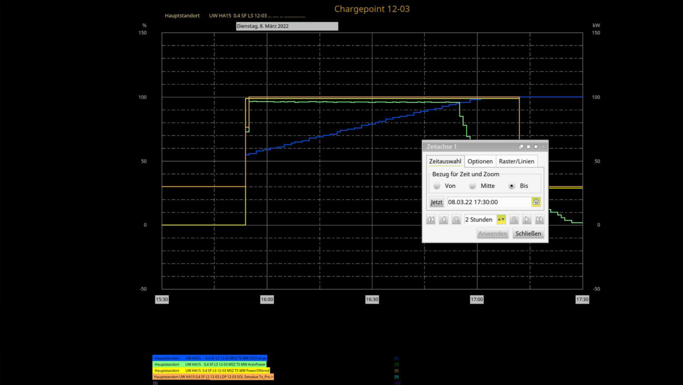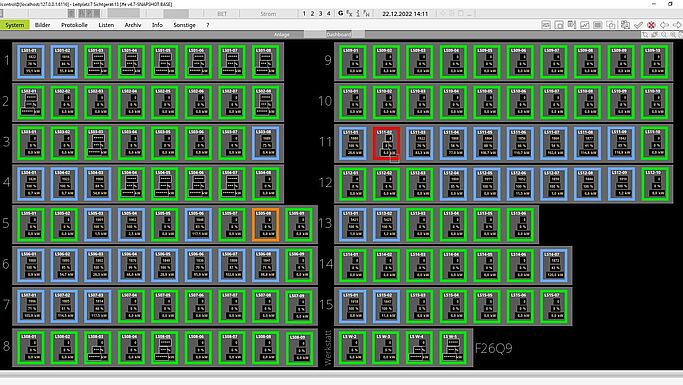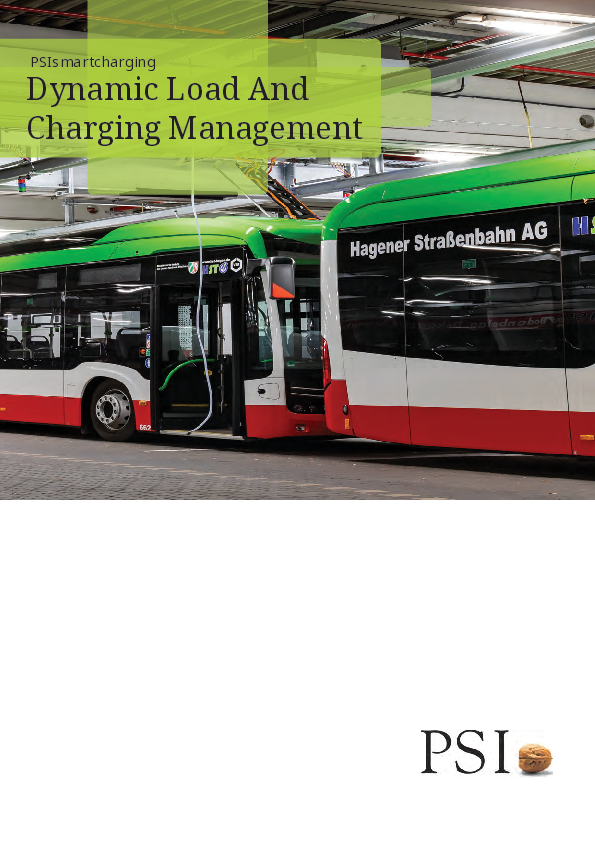![Charging_Place_Diagramm_ [Translate to English:] PSIsmartcharging](/fileadmin/_processed_/e/3/csm_Charging_Place_Diagramm_showing_one_Charger_with_reduced_Charging_Power_57aadc7a55.jpg)
Modern bus fleets are becoming increasingly electrified. It is therefore necessary to ensure the availability of the vehicles by means of a load and charging management system.
Support for electromobility requirements
The increasing number of electric vehicles - and therefore more charging stations - can lead to grid bottlenecks and outages due to simultaneous, uncoordinated charging. If a grid expansion is not feasible as a solution to the problem, PSIsmartcharging offers the ideal, future-proof platform for the intelligent control and optimization of charging processes. In addition to grid-stabilizing aspects, the system also takes into account operational requirements and economic factors
- in bus depots (public transport)
- for fleet operators
- in parking garages and public charging parks.
Smooth electric bus operation in our cities
In public transport, PSIsmartcharging works directly with depot management systems to ensure that electric buses are charged in good time and to the optimum extent for their planned routes, taking into account safety aspects and operational priorities. The power grid is permanently monitored and, in the event of imminent overload or restrictions in energy supply, the power is redistributed in such a way that the grid status is stabilized.
Electricity price changes can also be flexibly taken into account in charging planning. In addition, long-term additional income can be generated by providing balancing power. It is also possible to integrate additional battery storage at the depot to increase flexibility.
Benefits at a glance

-
Preconditioning of the fleet Heating, cooling or ventilation should take place before starting at the charging station to ensure an optimally operational traction battery with maximum range.
-
Optimized depot management Charging management and depot management - We offer you both modules separately or together as one solution.
-
Monitoring IT and system operation Monitoring of the IT network connections within the subsystems and the measurement and charging infrastructure in the depots is guaranteed.
-
Consideration of price signals from the market Flexible procurement of charging power on the market ensures your competitiveness.
-
Modular structure The modular structure of the system enables the greatest possible scalability and efficiency.
-
Standardized interfaces Standardized communication interfaces give you the freedom to procure vehicles and charging technology on the market regardless of the manufacturer.
Modules

Grid monitoring and control
Cyclical, automated monitoring of the local power grid and the equipment connected to the grid. Display of the status in network diagrams, alerting of the electrical operations management in the event of alarm messages, faults and limit value violations.
-
Power grid & equipment monitoring
Cyclical, automated monitoring of the local power grid and the equipment connected to the grid. Display of the status in network diagrams, alerting of the electrical operations management in the event of alarm messages, faults and limit value violations.
-
Energy purchase optimization
Economic optimization of energy procurement through increased use of own generation, variable electricity tariffs or marketing of own flexibility.
-
System monitoring
Monitoring of system services and communication interfaces and alerting system administrators in the event of faults and communication errors.

Load planning
The charging processes of the electric buses are automatically planned and prioritized in cycles in order to achieve the optimum charge level for the planned routes.
-
Preconditioning monitoring & control
Control of the preconditioning of the e-buses based on the planning of the rotations.
-
Charging process control
Control of the charging processes depending on the prioritization of the e-buses and the currently available grid connection capacity and the operational limits of the local lines and equipment currently in use.
-
Charging process monitoring
Cyclical automated monitoring and control of charging processes according to the charging plan.
Typical users

Distribution grid operators
Due to a lack of measurements and central evaluations, the load status of the distribution grids at medium and low-voltage level is insufficiently monitored. A possible high simultaneity of charging processes in the non-public sector is expected to lead to a significant increase in grid load. As an intelligent and cost-effective alternative to grid expansion, PSIsmartcharging is the charging control solution with the following options, among others:
- Remote control of the LV and MV networks
- Grid-friendly controllability of the charging facilities (load shifting)
- Utilization of local synergy effects between e-mobility and feed-in from renewable energies
- Adaptation of the regulatory framework conditions
-
Intelligent charging control
The power grid is permanently monitored. In the event of imminent overload or restrictions in energy supply, the power is redistributed so that the grid status is stabilized again.
-
Compliance with all security requirements
PSIsmartcharging is designed to meet high IT security requirements, including KRITIS-compliant operation. The system is therefore equipped to meet EU security requirements for critical infrastructures and industry requirements.
FAQ'S
How does PSIsmartcharging work?
PSIsmartcharging is a dynamic load and charging management system with integrated energy management that monitors and intelligently controls the distributed charging infrastructure and the associated electrical infrastructure at the operating sites in real time.
The main tasks of load and charging management are:
- Integration, monitoring and control of charging stations and charging processes
- Monitoring and control of the electrical infrastructure of the depot power supply systems
- Avoiding overloads at the grid connection point of the depot power supply systems and at electrical equipment (transformers, lines, sub-distribution boards) within the depot power supply systems
- Connection to upstream systems, e.g. depot management (DMS) and intermodal transport control system (ITCS) for the transmission of operational requirements for charging control and for the forwarding of information on charging process and charging infrastructure status data to these systems
Control and monitoring of the preconditioning of e-buses
When assigning charging power to the individual charging stations, the optimization of the LLM takes into account operational constraints such as operational priorities or departure times. The integrated energy management system monitors the current energy supply and distribution status in the depot and optimizes the energy supply at the grid connection and the distribution in the depot. Dynamic specifications from the energy suppliers and the grid operator are taken into account to ensure that the e-bus fleet is operated economically and in a way that supports the grid.
What is OCPP?
OCPP is the “Open Charge Point Protocol”, a standard developed specifically for the field of charging stations for electric vehicles. OCPP enables communication and control between charging stations and various backend systems, such as charging management systems.
Currently, version 1.6 of the OCPP standard is most commonly used by charging station manufacturers. The further development OCPP 2.0.1 is already available and is slowly finding its way into the market. PSIsmartcharging supports both versions of the OCPP standard.
What is ISO 15118?
ISO 15118 is a standard of the International Organization for Standardization consisting of a series of technical standards. In short, the series of standards regulates the communication interface between the vehicle and the charging station or power grid.
The implementation of ISO 15118 enables the following functions, among others:
- Establishing and maintaining a connection
- Communication of charging data and load control requirements
- Automated management of charging processes
- Exchange of measurement values for performance monitoring and control
ISO 15118 is an important standard that helps to integrate electric vehicles into smart grids and manage interactions between electric vehicles and these grids.
What is VDV 261?
VDV 261 is a data communication standard from the Association of German Transport Companies (VDV) and uses ISO 15118 as a basis. It describes the communication between electric vehicles and charging stations for a special application of value added services, namely the preconditioning of vehicles.
Preconditioning involves heating, cooling or ventilating a vehicle during or after a charging process.
PSIsmartcharging uses VDV 261/ISO 15118 to automatically transmit the necessary data to the connected vehicle in order to precondition it in the best possible way by the desired departure time and to maintain an optimal battery charge level for the trip.
What is VDV 463?
VDV 463 is a document issued by the Association of German Transport Companies (VDV) that defines the interface between charging management systems and upstream systems such as depot management systems and intermodal transport control systems (ITCS). In this regard, VDV 463 specifies both the protocol to be used and the data format.
Among other things, the following information is exchanged via the interface:
- Transfer of loading requests by one of the upstream systems (priorities)
- Information on the current loading status from the loading management system to the upstream system
- Control and monitoring of preconditioning according to the upstream systems
How does vehicle monitoring work?
On the route, the vehicle continuously reports (E-Bus actual data) to the depot management. This includes, among other things,
- battery capacity (SOC, State of Charge)
- vehicle ID
- mileage
- energy expended
The depot receives data relevant to operations (vehicle master data, service and timetable data), environmental and weather data (interface to a weather service), as well as data from the operations control system. Subsequently, the battery charge state and remaining range are constantly compared with the open trips, taking into account the above-mentioned vehicle master and trip data, as well as operational requirements, such as supply and workshop orders. This data forms the basis for the forecast calculation of the energy requirement for the next trip/route by PSI's own AI-based optimization core Qualicision. This results in a prioritization of the charging processes of the e-buses with the aim of (in the event of bottlenecks) only achieving the actual required state of charge for the planned trips. Finally, the depot management sends this priority list, based on the operationally relevant and e-bus data, to the LMS (PSIsmartcharging) via the common interface VDV 463.



